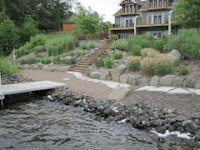 |
| Example of no filtering area |
Rarely do I meet a lakefront landowner who is welcome to the idea of planting the entire shoreline with cattails and bullrush's in order to be eco-friendly. No, although in principle it may be whats best for the lake, lakefront properties are purchased for their functionalities such as swimming, beaching and the viewing of wildlife and water activities which make this approach unrealistic in most cases.
 |
| Example of good filtering area |
So what's the solution to your lakeshore problem?
Our approach is simple. If you already have a filtering area between your lawn space and the lakeshore, than rip-rap can be installed alone. A filtering area consists of a planted area or a non-lawn area of four feet or more depending on the size of the plants root systems within the filtering area. If you have a lawn space that abutts to the shoreline, we suggest creating a filter area or swaling the lawn surface to move the run-off water to a filter area.
 |
| An excellent filtering area |
How does one install rip-rap?
The size of the rip-rap pieces (usually boulders) are determined by three things.
- The position of the property in relation to prevailing winds.
- The amount of drop from the top of the bank to the waters surface.
- The steepness of water depth from the bank
Winds
The more wind- the more damaging the waves will be in times of high water. The wind also effects the damage caused when the ice breaks up in spring. High wind areas should never use anything smaller than 16 inch boulders at waterline height.
Drop from bank to water
The DNR recommends that the rip-rap extend 4 feet out into the water for every 1 foot of drop from the top of the bank (foot level) to the water level.
Water Depth
The more the water drops off, the more material will be needed to extend the rip-rap into the water to meet the 4 to 1 ratio without the rip-rap collapsing.
When is the best time to install shoreline protection?
Unless there is zero access to your lakeshore, summertime is the best time for shoreline restoration projects. In the case of limited access, smaller sized rip-rap can be hauled in by power wheelbarrow or a Dingo machine. For zero access situations, one should consider a heavily planted shoreline as an option to an on-ice winter installation that will not always give you the finished results that you may expect.
How does a shoreline get installed during the winter?
A company will transport rip-rap over the ice and pile them up on the ice and the bank. When the ice melts, the rip-rap material falls into position. The underlayment fabric (woven barrier between the bank and rip-rap) is normally preplaced in the fall, in advance of winter.
Can a beach become a filtering area?
In short, No. Unless there are plants that can absorb the nutrient run-off before it enters the lake, there can be no real filtering.
 |
| An example of grass at the edge laden with large amounts of fertilizer run-off. The excess which cannot be absorbed goes into the lake. |
 |
| Introducing wildlife invites wildlife |



No comments:
Post a Comment